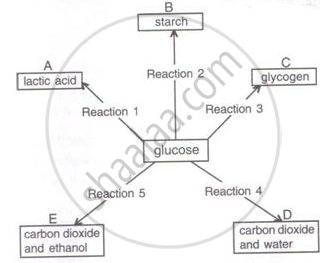Advertisements
Advertisements
प्रश्न
The question has four options. Choose the correct answer:
Less energy is liberated in anaerobic respiration in yeast in comparison with aerobic respiration because
पर्याय
Energy is not formed by oxygen.
Less CO2 is formed.
Energy is left in alcohol.
Yeast requires less energy.
उत्तर
Energy is left in alcohol.
APPEARS IN
संबंधित प्रश्न
Distinguish between the following:
Aerobic respiration and Anaerobic respiration
In which type of respiration, aerobic or anaerobic, more energy is released?
What type of repiration takes place in humans?
Write the overall chemical equations of the two kinds of respiration in plants.
(i) Aerobic:
(ii) Anaerobic:
State if the following statement is true or false. Correct the statement if it is false.
Respiration that takes place through the skin is called pulmonary respiration.
Given below are chemical reactions (1 to 5) involving glucose and five other chemical products (A-E).

Write the reaction number of the following:
(i) Anaerobic respiration in plants __________
(ii) End products in aerobic respiration ____________
(iii) Reaction occurring in liver _________
(iv) Anaerobic respiration in animals ________
(v) Storage in the liver _________
Fill in the blank:
______ is the last product of glycolysis.
Fill in the blank:
The final hydrogen acceptor in aerobic respiration is ______.
Answer the following question.
How are glycolysis, TCA cycle, and electron transport chain-linked? Explain.
Differentiate between Aerobic respiration and fermentation.
Describe and name three stages of cellular respiration that aerobic organisms use to obtain energy from glucose.
The following identifies the electron acceptor present in the respiratory chain.
Identify the end products of pyruvic acid during alcoholic fermentation.
Diffusion of gases takes place from ______.
Find out the number of ATP molecules produced through oxidative phosphorylation of NADH, produced through breakdown of 12 molecules of pyruvic acid in Kerb cycle?
During glycolysis the compounds PGAL and DHAP are formed from fructose 1, 6 diphosphate by ____________.
How many ATPs will be effectively produced during the production of 1 molecule of acetyl Co-A from 1 molecule of pyruvic acid?
____________ catalyzes the conversion of glucose-6-phosphate to fructose-6-phosphate.
What are the adaptations of leaves for photosynthesis?
Sequence of cytochromes in respiratory chain is ______.
